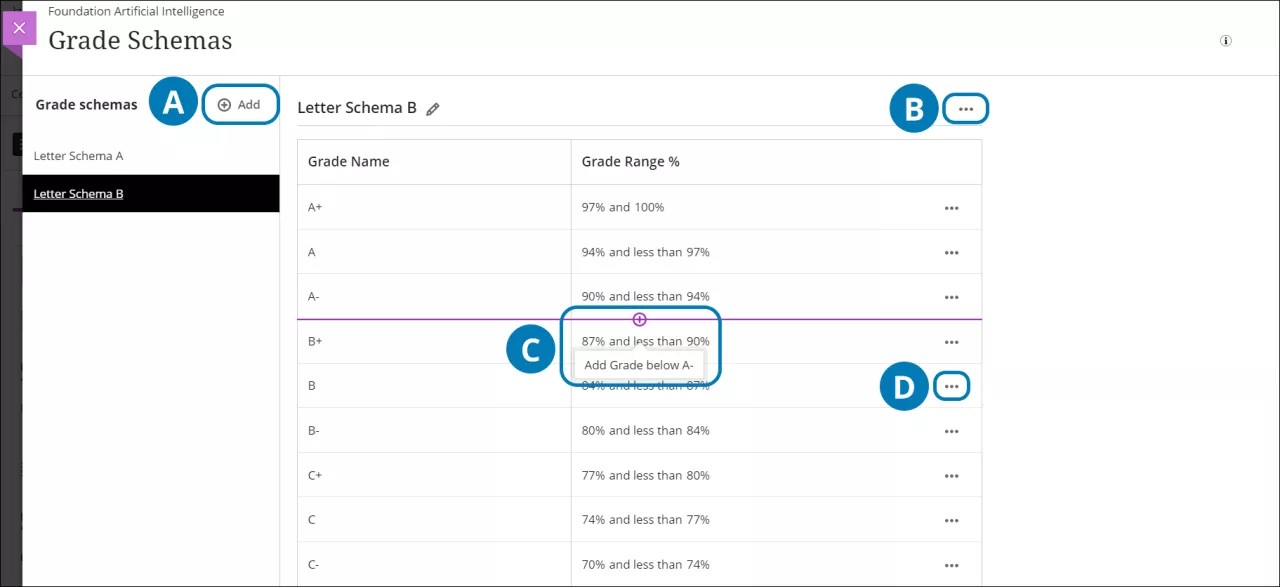Your institution controls which tools are available in the Original Course View. The gradebook is always available to instructors in the Ultra Course View.
Using grading schemas
Within your courses, grades are displayed in the Gradebook and on the Submissions page for your assessments. You can choose to display grades in different ways with grading schemas. A schema takes the points scored on an item and compares them to the item's total points possible to derive a percentage. This percentage is then mapped to a score range and displayed as a grade, such as a letter (A, B, C) or Pass/Fail.
The default grading schemas available are:
- Points.
- Percentage.
- Complete/incomplete.
- Letter.
Instead of displaying grades, the complete/incomplete schema shows whether a student completed their assessment.
All default and custom grading schemas in your course appear in the Grade using menu for new and existing graded items.
If a grade input is invalid, the grade will revert to its previous state or value.
Manage grading schemas
From the Gradebook you can make changes to the grading schemas in your course. Select the Settings button to access the Gradebook Settings panel. Select Manage Grade Schemas to view the schemas available in your course. The default schema's name and values are defined by the administrator, but you can create new grading schemas and customize existing ones.
If you make changes, they only apply to the course you're in.
If your institution makes changes to the default grading schema, the changes aren't reflected in your course. Only new courses created after the change have the edited schema.
You can rename the default schema in your course and make changes to the Grade Ranges to suit your needs. The changes that you make to the default grade schema will only apply to your course.
Text schemas created in Original are unsupported in the Ultra course view. When converting courses, text schemas convert to a points schema. After conversion, you can create and apply an alternate schema as needed.
Multiple grading schemas
You can have up to 100 grading schemas per course, giving you the flexibility you need to use the most appropriate grading schema for each assessed activity in your course.
A. Select Add to add a new grade schema. Enter the schema name. New grade schemas have two rows by default; each row contains a grade name and grade range.
B. To copy or delete a schema, select the options menu. You can only delete schemas that are not in use.
C. To insert a row, select the plus sign (+).
You can edit the grade ranges by selecting the values. Start from the bottom row and work your way up the rows. You can make the uppermost value greater than 100%. For example, if students earn 100% or more, you can assign A+.
D. All rows have an options menu. Select it to edit or delete a row. At least two rows must remain for the schema to be valid, and you can't delete the last row.
When you add or delete rows or edit values in the schema, the remaining values get adjusted automatically. This ensures that no numeric gaps exist in the schema.
Copying items and courses
If you copy assessments and activities from other courses that you teach, they keep their grading schemas. If you copy an entire course, all grade schemas are included even if they're not aligned to any gradable items.
Gradebook calculations and grading schemas
The calculation schema displays grades as points, letters (A, B, C), or a percentage with the grading schema you choose for each assessment. The schema takes the points scored on an item and compares them with the item's total possible points to get a percentage. This percentage is mapped to a range of scores and displays a grade, such as a letter.
Example:
For the total grade, a student's raw numeric score is 88 out of 100 points possible. In a grading schema in which a percentage of 87 to less than 90 equals a B+, the student's score of 88 results in a B+.
At this time, regardless of the range of values you use in your schema, the grade pill colors and corresponding percentages don't change from the Ultra color scheme. Your correct grade appears, but the color matches the Ultra color scheme. However, your institution can disable the color scheme for all courses. Visit the Assign Grades topic to learn more.
More on grade columns and overall grade



